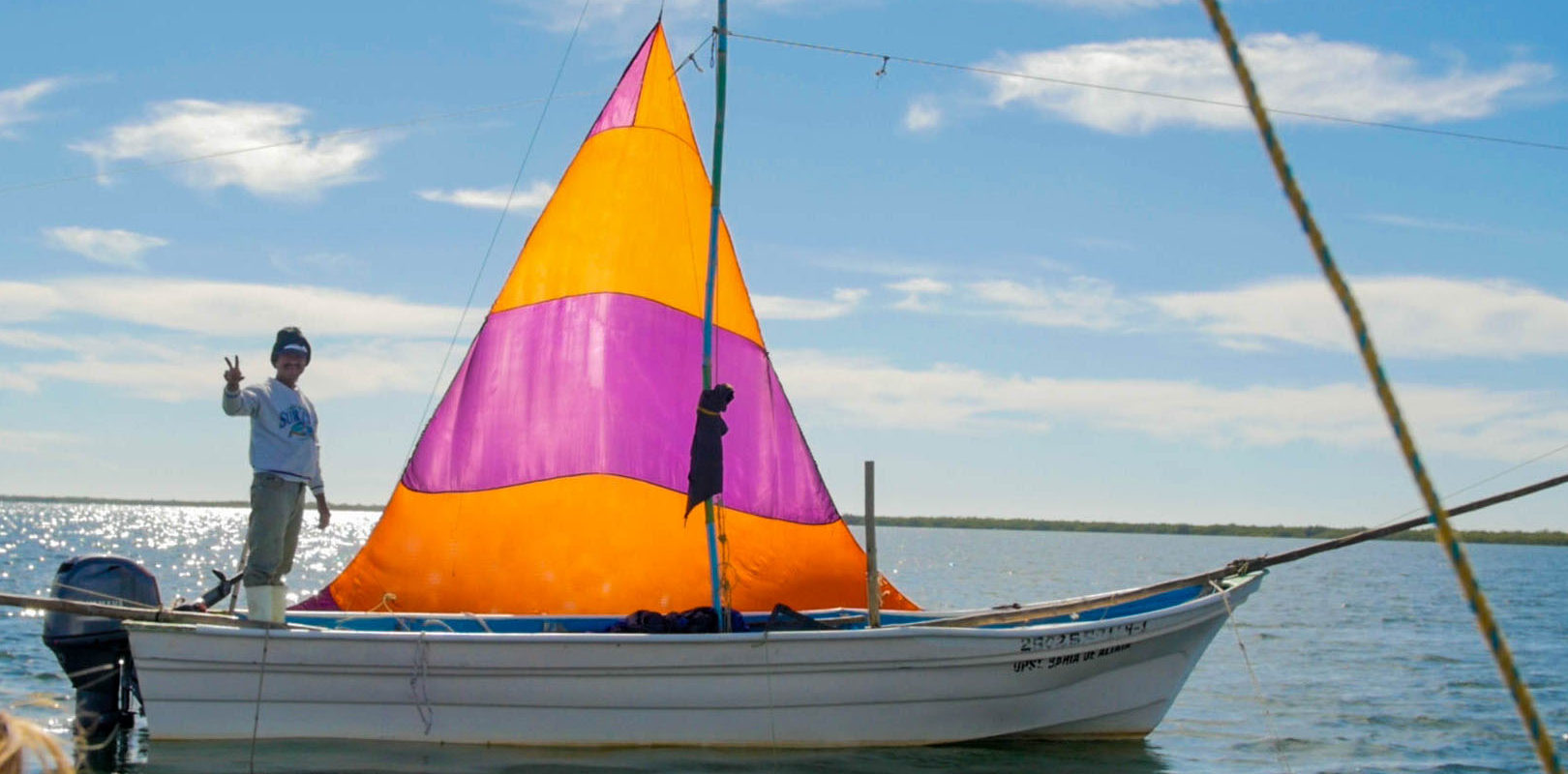“Whatever you do, don’t go to Altata.”
These were the last words we heard as we cast off our dock lines in Guaymas. We were about to sail 300 miles with limited charts but plentiful warnings—with the goal of getting to this near-mythical town protected by a bar that might as well have been filled with dragons.
Before we could reach Altata’s sheltered bay, we would have to cross a dangerous bar. Bars form at the mouths of rivers or bays where tidal currents create shifting sand piles underwater—which make breaking waves on the surface. We read reports of 15-foot breakers stopping other sailboats. The only people we knew who sailed the coast (other than the dock-warners) had sailed two nights in a row, skipping this stop so they wouldn’t have to contend with this boat-threatening obstacle.
I admit, I wanted to skip it: the stories plagued me. But I had a nagging feeling that, in Altata, we might find a coastal life we hadn’t seen yet: something rural and genuine, a village holding on to its roots before the resorts gobble up the coastline—or before sea level rise threatens to swallow this low-lying town altogether.
Little did I know that once inside Bahía de Altata, we would find ourselves completely surrounded by a whole different breed of sailboats—with one piloted by a young man who would show us a hint of the future of fishermen everywhere.
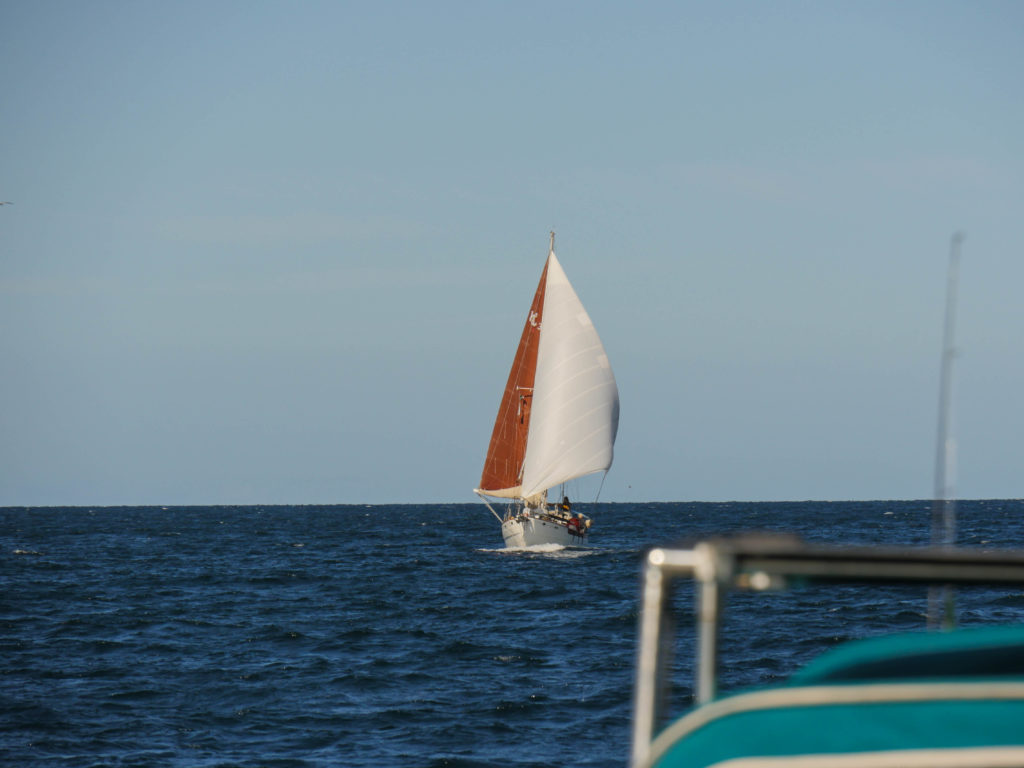
This is a taste of sailing offshore into the night with the wind at our backs. (Holding the camera level in rolling seas is not always possible.)
****
I didn’t sleep much the night we sailed to Altata. Before evening, I called the port captain in the town and asked if we could get accurate tides and a pilot to navigate the bar. All cities and many towns in Mexico have a port captain that directs port traffic, and this one has a friendly reputation.
“Un piloto?” the woman said on the other end, sounding surprised. I didn’t know if I should read this as a good sign or an ominous one. She took my email address to send me the tides, and she promised the captain would call with info about a pilot.
As morning light erases the night over the sea, seeping in behind the clouds, there is still no word from the port captain. We would be crossing the bar alone (although we discovered later that they sent out a pilot boat, just a little later than our arrival.) Using our VHF radio, we call back to our ‘buddy boat,’ Jon and Shannon aboard their 33-foot sailboat Prism.
“I think we’ll catch you guys soon,” Jon says through the static, but we can’t see their mast light on the horizon. I want to wait for them, but we have to cross the bar at slack high tide, when the water is highest and not moving in or out of the channel. If we miss it and catch the outgoing tide instead, the movement of water out of the channel creates steeper waves as it rushes out to sea.
My partner Josh spots the seabuoy that marks the entrance to the channel in the gray light. As we round the buoy and start sailing into the wind, we roll up our jib and use only our mainsail. On the horizon to the north, I’m relieved to see the tan bark (maroon) sails of Prism touch the horizon. I call back to them intermittently on the VHF, providing a tense play-by-play in the slow game of sailing into an unknown bar so they can know what to do—or what not to do.
“I think I see channel markers,” Josh says, squinting in the flat light. I scramble for the binoculars under the dodger and stand on the seats in the cockpit to discern the horizon. There they are: the comforting buoys of red and green. Our boat sails well when ‘close to the wind,’ or nearly heading into it, and our mainsail keeps us moving through the buoys.
I scan the horizon rapidly, searching for another set of buoys that may not exist. We head toward distant markers to starboard—until I realize these are shrubs on the land. Despite all our maps and mapping technology, in this moment we rely only on our eyes.
“To port!” I yell when I finally discern the next set of markers. Josh cuts to the left and we steam ahead. My heart pounds in my ears, waiting to see what we will find when the channel constricts. I know our boat can handle some surf and I trust it, but, despite living in a digital era where companies like Google map underwater reefs, sailing the coastal waters of Latin America is still as full of uncertainty (and myth) as it was 100 years ago. As modern sailors, we still need to rely on our wits, skill, and boat to make quick decisions when conditions deteriorate. My head aches from lack of sleep and anxiety of the unknown. I have been worrying about this moment for two weeks.
As we approach the second set of buoys, dark waves roll by us outside the channel, barreling and flinging white spray over their tops. As we pass through the second set of buoys and turn into the channel, I blink into the howling wind in disbelief: the waters inside are almost completely flat. I call back to Prism: it seems like we made it!
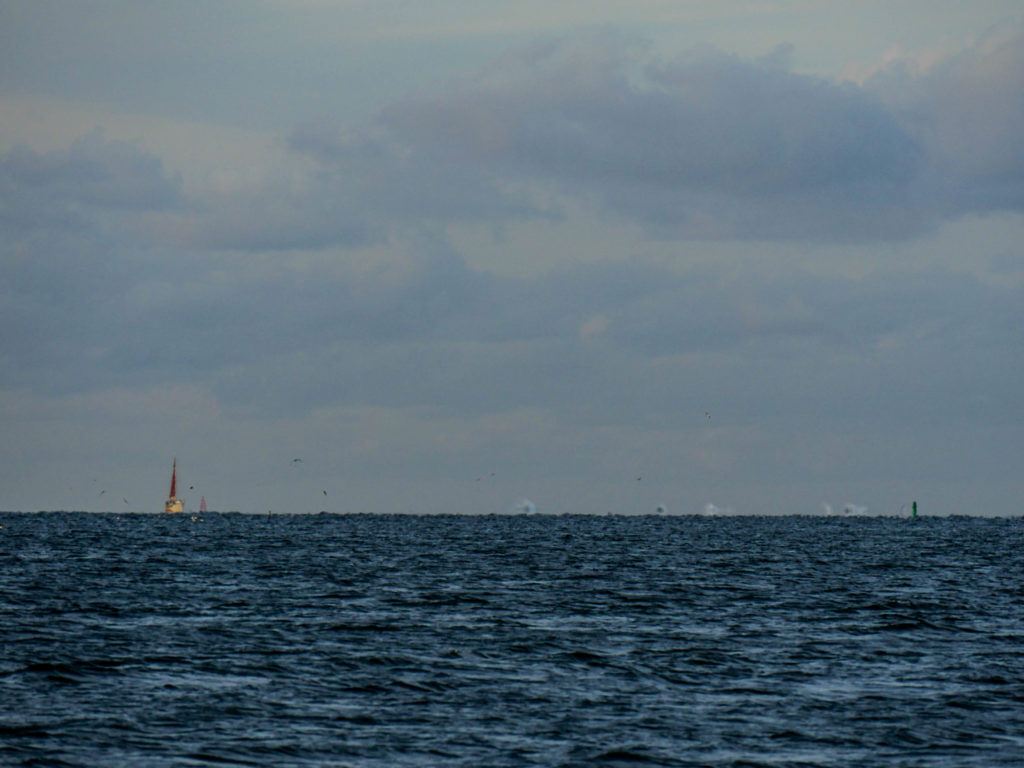
As we sail into this near-secret bay, the warnings, the finger wagging, the stories in hushed tones fade like a fairy tale. By carefully timing our entry over the bar, (at high tide and with smaller south swell,) we cracked the code. We wait at the third set of buoys for Prism, since they have noticed that their charts are uselessly inaccurate, and we all sail up the bay together to the town in something like euphoric exhaustion.
***
We are the only sailboats here, but suddenly we’re surrounded by sails.
Billowing triangles of magenta, yellow, or orange and blue fill the small bay. As we simultaneously drop our anchor with Prism in front of the town malecón, we stare in wonder as the water lights up with the colorful sails. They billow from the center of fishing pangas, slowly towing the boats sideways through the bay. There are forty boats, but no two sails are the same color. Through the haze of sleep deprivation, I feel like I’m in an enchanted dream, where the pangas eschew their motors for an ultra-slow motion procession before the town, like so many Mexican street festivals, but this one on the water. I can’t believe that we are the only sailors witnessing the rainbow parade. A few pangas without their sails up slowly approach our boats They ask where we came from and thank us profusely for coming to their town. As one motors away, he turns over his shoulder and calls bashfully, Bienvenidos! Welcome!
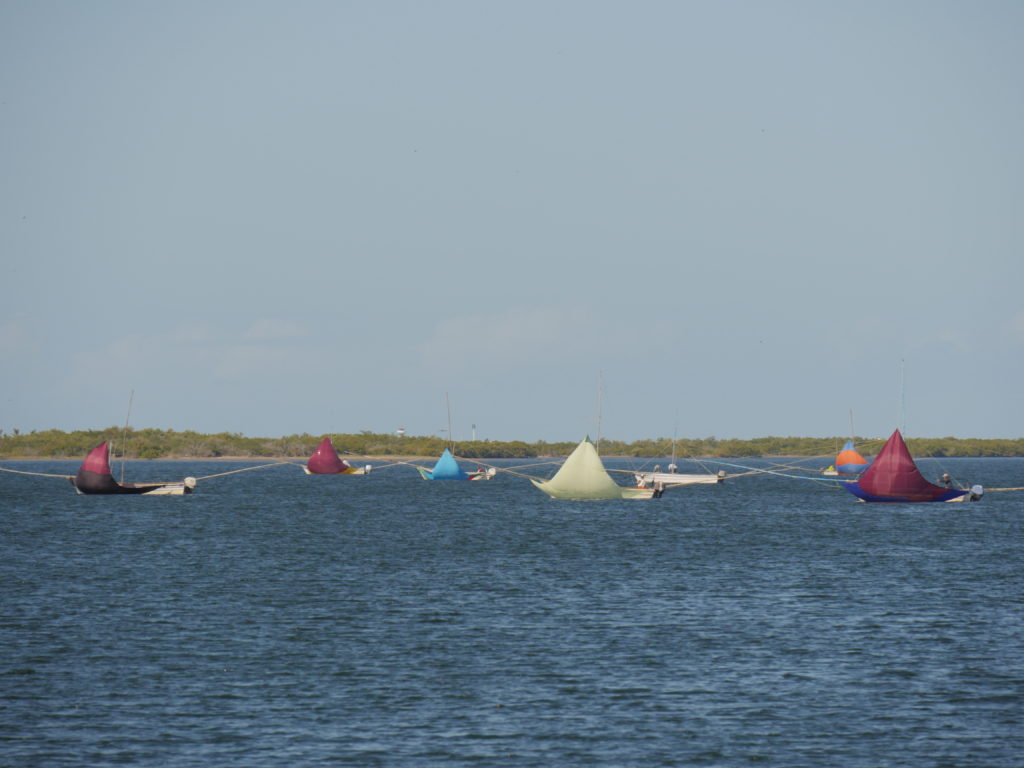
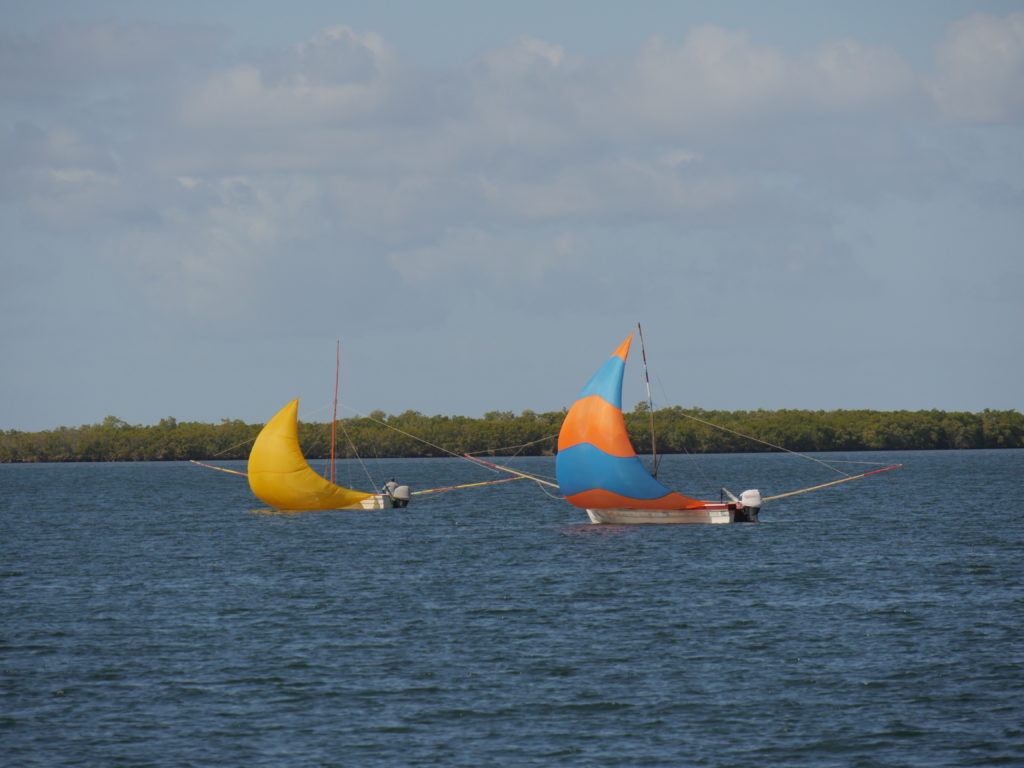
Another panga motors a slow circle around our boat, its young pilot peering onto our decks. I step to the rail in the cockpit and sit down to chat. He pulls alongside and uses a thin, waxy plastic cord to tie his panga to our sailboat. This is Alfonso.
Within a few minutes Alfonso is my favorite visitor yet to our boat. His unassuming way and his easy chatting give us an open window into his life. Our shared curiosity is two people in their sailboats, each asking the other how it works. Where’s your motor? He wants to know. It’s inboard, I tell him. Were you born here? I ask him—and of course he was. My next question: Do you have family here?
“Yes, a nine year old daughter—and my wife is three months pregnant,” he says, glowing with pride. When I effusively congratulate him, he tells me that he and his wife had thought they were too old to have more kids—at twenty-nine.
“But then they told me no, it’s possible!” he says sincerely. I tell him many of my friends did not have kids until 40, and he nods appreciatively.
Alfonso lives in the next town over and drives about 30 minutes to get to the coast every day. He shows me all of his different sails: the big sail, the smaller sail for when it’s really windy, and the underwater sail when there is no wind but they can use the tidal current. He picks out the fabric and brings it to a seamstress in town.
Alfonso explains the difference between the sails in his boat. The first dark red sail is for use underwater when there is no wind, only current. The blue and yellow sail is for the wind. Finally, the net catches jumbo shrimp as it drags on the bottom of the bay.
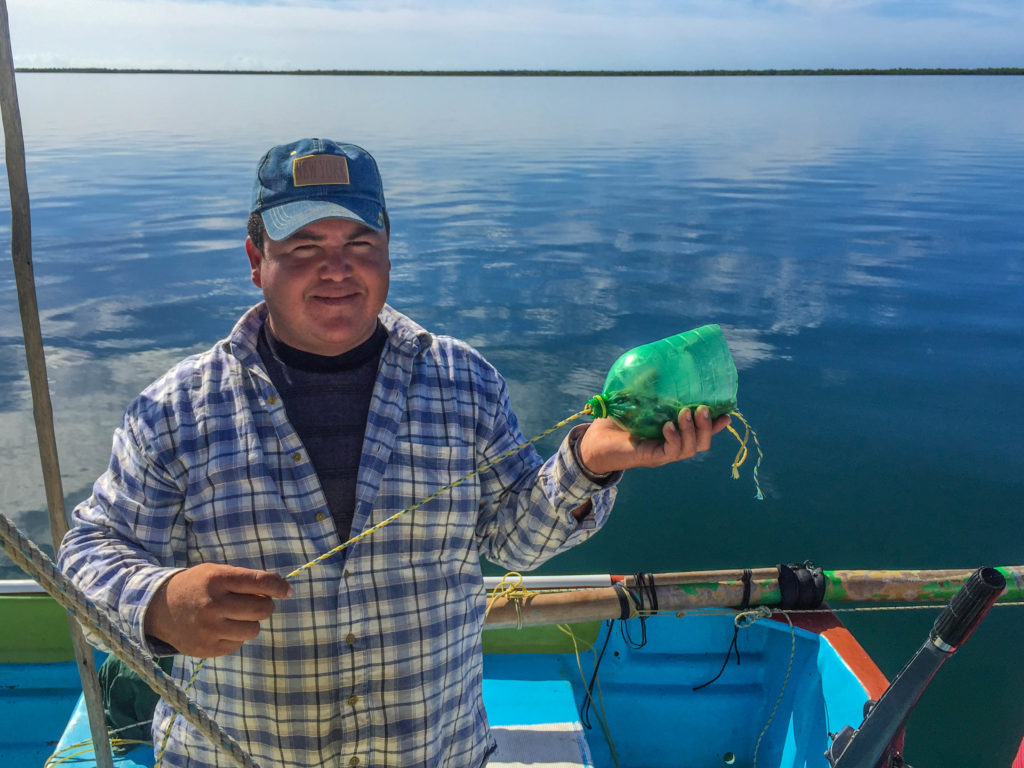
As he talks, I think about his life. Typically, there are at least two or three fishermen in a panga. But the sailing fishermen here are solo in their boats. Alfonso seems like an outgoing guy, and I wonder if he feels lonely in his panga. I ask impulsively if we can go out fishing with him. Sure, he says. God willing, we can go out after the weekend.
“Si Dios quiere,” he said, literally ‘if God wants.’ It leaves room for uncertainty for all parties. Yet while the expression reflects the deep Catholic roots of Mexico, it hints at Alfonso’s experience as a Mexican fisherman. Individuals living off the sea have had so little control of their catch, or the government regulations (or lack thereof), in 500 years of Mexican history. Despite being the economic backbone of the country, farmers and fishermen have always been at the whim of a capricious government, and they are increasingly marginalized by international trade that prices them out of their markets.[1]
Climate seeps into the world of food producers in the same slow, insidious way: small global shifts could mean drastic local changes. Changes that affect fishermen already occur on a global and local scale. These include warmer water, more carbon dioxide dissolved in the water (which makes it more acidic,) more frequent and potent storms, changing weather patterns, and sea level rise. These changes trickle up the food chain from shrimp to fisherman. Warmer water means that some species will flourish as others decline, all while algal blooms choke the oxygen out of coastal waters. More acidic water affects anything that grows a shell, making their outer skeleton thinner and thus more vulnerable. Storms change both the coasts and the underwater topography—and some can devastate vulnerable fish populations, nevermind the resources on shore. If weather patterns change in Altata, the daily north winds on which these fishermen rely for their sails could be lost entirely.
Finally, rising water is already creeping toward this little town. Alfonso tells me that, until last year, the fifteen restaurants that line the boardwalk were only in the sand. At high tide, customers would sit with their feet in six inches of water. (This is only charming in the summer when the water is warm.) But the town found the funding to construct a new malecón, with stamped pink concrete and hundreds of streetlights. The boardwalk provides a barrier now between the sea and the tourists—in an aesthetically pleasing way.
But they really should have made it longer, Alfonso gripes. Something more like Mazatlán. Mazatlán is city of nearly 500,000, with Altata around 3,000, but I can see his point: the short boardwalk constricts any growth along the waterfront, and it limits a favorite Mexican past time that is a staple of coastal life: the evening stroll on the water.
At the same time that the town created a new space next to rising waters, they did not constrict the developers on the other side of the barrier island that separates Altata from the Sea of Cortez. Less than two years ago, luxury homes sprouted from the sand next to the water’s edge—and in less than a year succumbed to the tides. The developers were advised to build further away from the water, but instead planted enormous boulders in front of the homes. This may have partially worked to protect a few, but more than one unlived-in house had cracked open and started to dive into the sea.
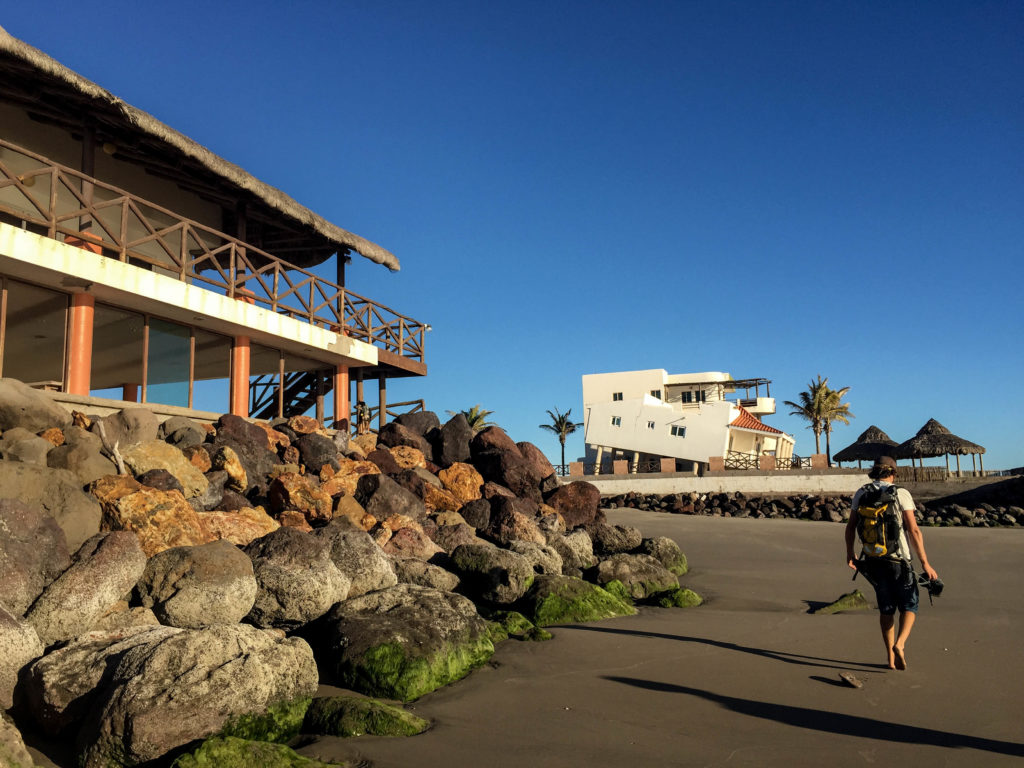
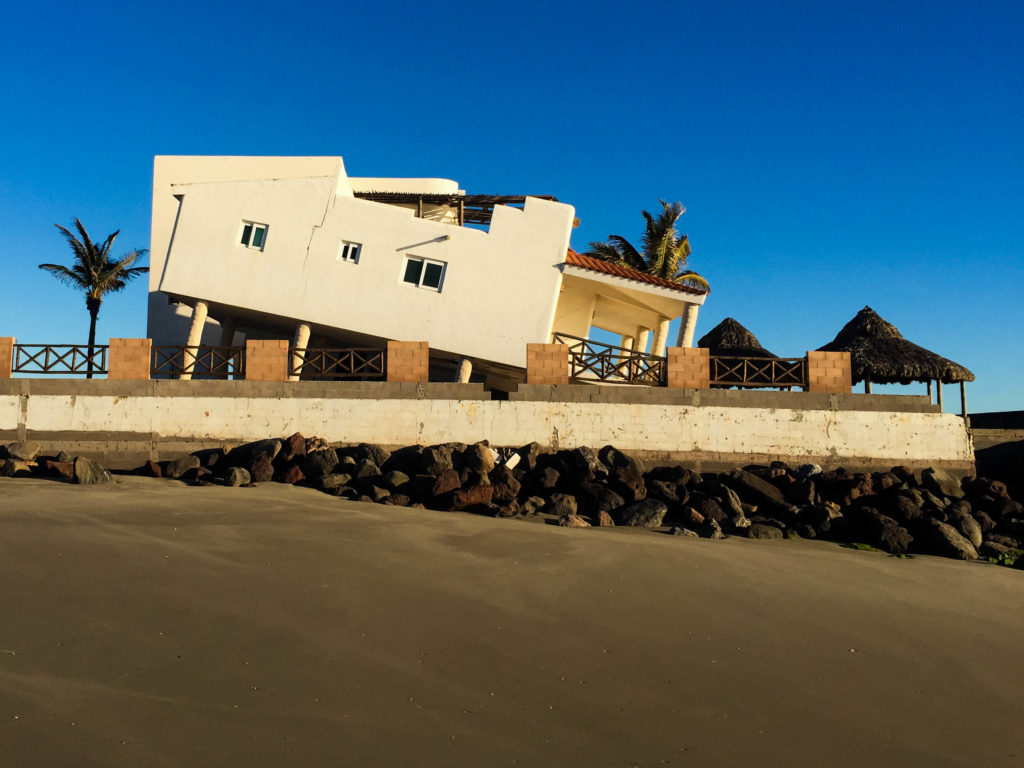
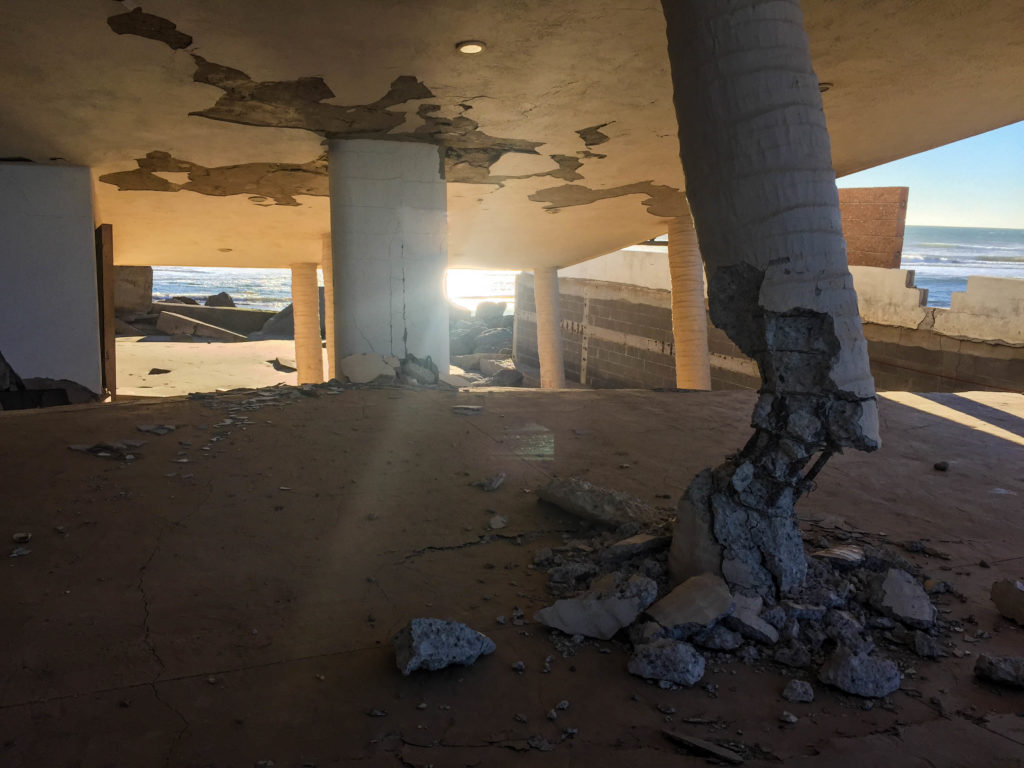
Alfonso is already adapting—because conditions other than climate have forced his hand. He can’t sail on the weekend because he has a second job on Fridays and Saturdays as a waiter in a restaurant. He tells me a story about last week: one of his fellow waiters pronounced a word with a local accent, and the customer from Mexico City was so offended that he didn’t tip. It makes me realize how dependent these servers are on tips—just like in the U.S. I worked as a server and I appreciate that work, I tell him. But I don’t know what it’s like to lose a tip and have it jeopardize the amount of food I can put on the table.
***
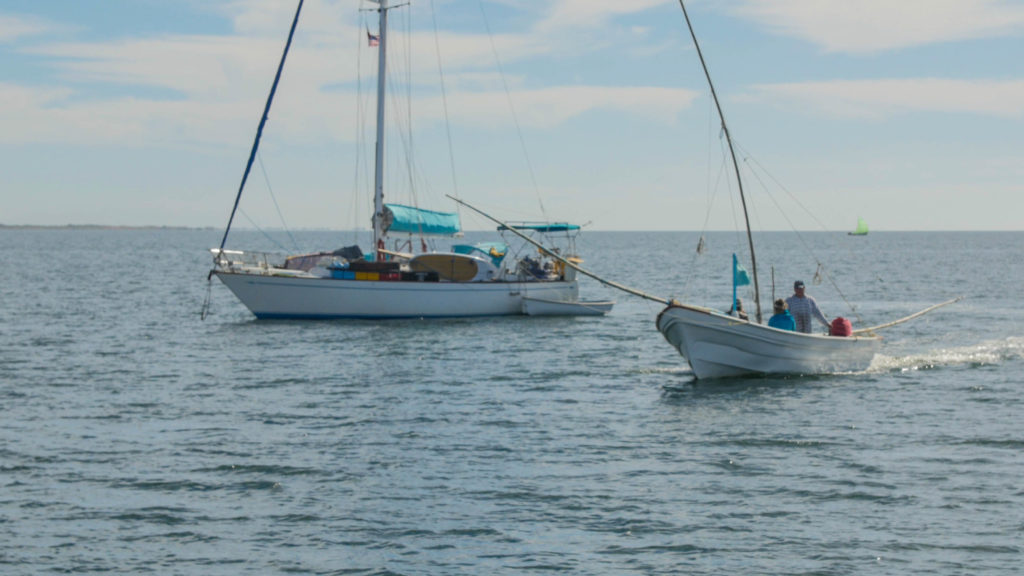
A few days later, that same waxy plastic rope that Alfonso used to attach his boat to ours cuts into my hands as I pull up a net from the bottom of the bay. I’m standing on the floor of Alfonso’s panga, hauling up our catch from one pass in front of town. I watched him pull up the line on the first net, quickly and gracefully moving hand over hand. But when I try to go that quickly, the net is too heavy and the thin rope too sharp, even for my hardened sailing palms. I brace one foot on the side of the panga and continue to haul the yellow line impossibly slowly, which coils easily on the bow.
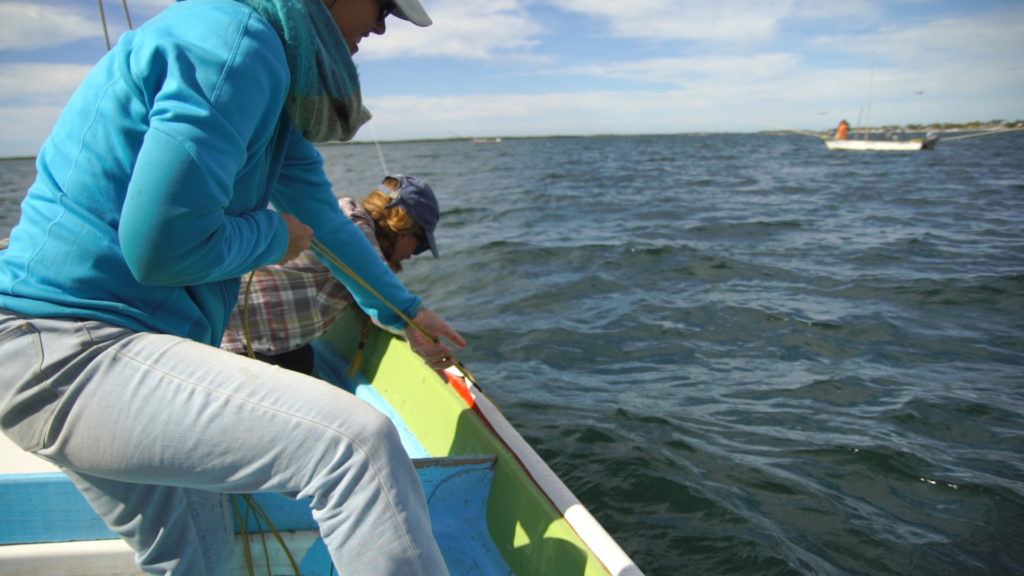
When I finally have the net onboard, Alfonso lets out a hoot, his round face lit with a grin. A great catch! Between the two nets we have pulled in 25 jumbo shrimp.
When shrimp want to move quickly, they squirt into reverse, rapidly pinching their body into a C-shape. When they use this trick to escape on the panga’s floor, it makes them hilariously difficult to grab. Once we sequester them into a cooler filled with salt water, Alfonso starts the motor and we glide back to the top of the bay in less than ten minutes to start another round of fishing.
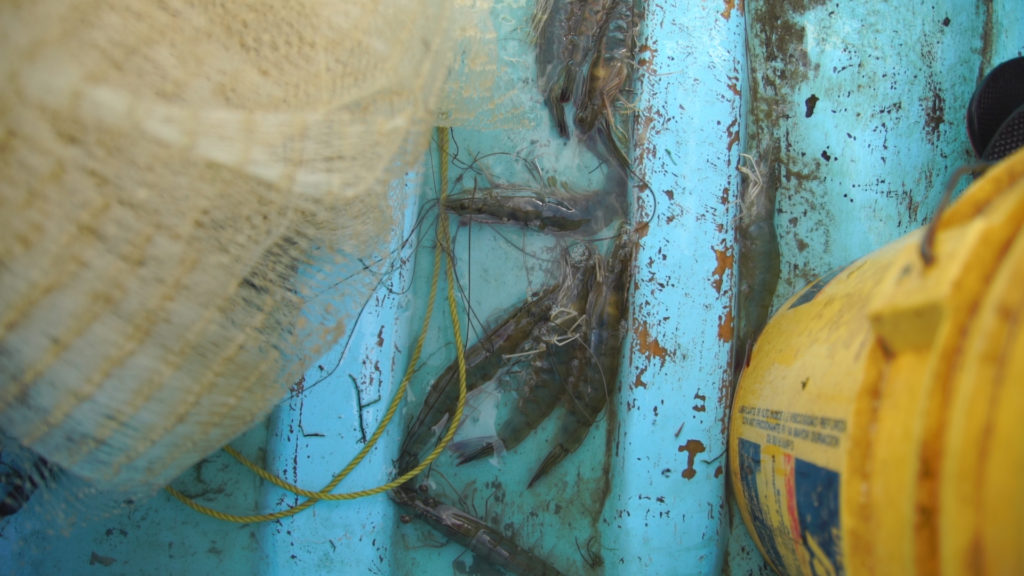
This practice of using a sail seems smart to me, but when I say this to Alfonso he smiles and shakes his head. Huevon, he calls it. Lazy. The men used to be really strong, he tells me, and they would throw a net overboard, and then immediately haul it up, instead of dragging the net using the power of wind in the sails. The fishermen started using sails only 40 years ago to harvest the sea. Despite Alfonso calling it lazy, it still seems wise to me to harness the wind and save money on fuel.
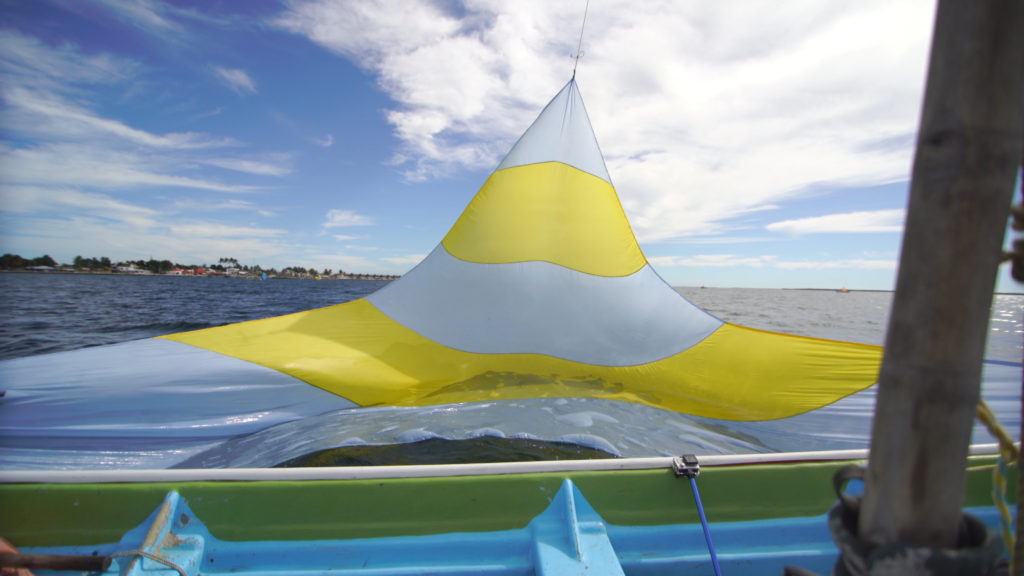
On each sailing panga, there are two nets that extend from the bow and stern, held wide by 15-foot-long bamboo poles. The nets drag gently on the bottom using small weights. Alfonso can feel the proper tension for the net with one finger, and he shows us how to hold a finger on each line to feel the ping on the line when it catches a shrimp.
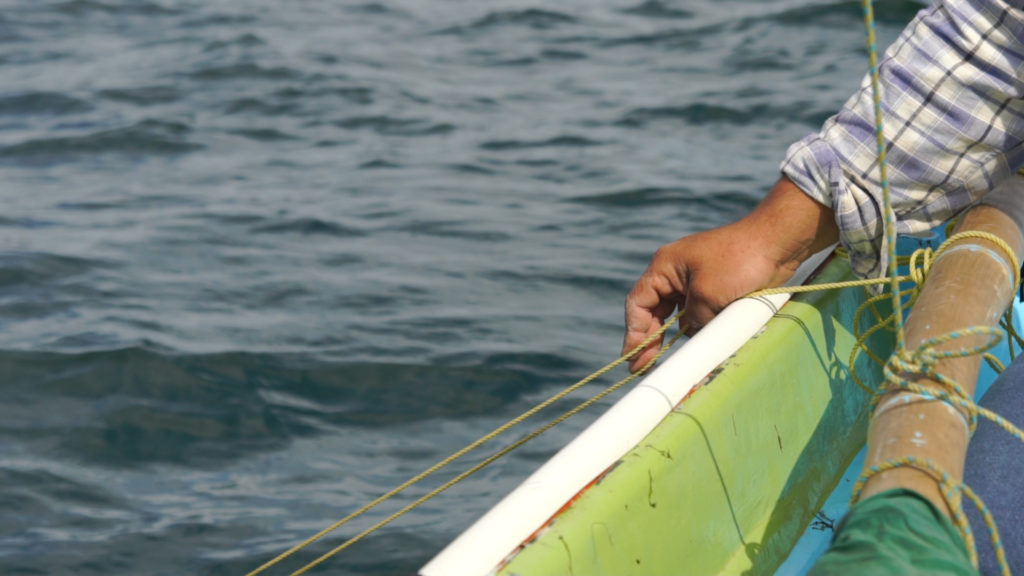
A third bamboo pole rigged upright in the center of the panga functions as the mast for the sail. On our sailboat, the sails are made of tough, plastic-like dacron, but Alfonso’s sail is lightweight nylon with three strips: yellow, blue, yellow. He tells me he chose the colors. They’re all different, I note aloud, and he points to a boat further up the bay with a sail the same colors as his but with opposite stripes. That’s my father, he says proudly. This is a family affair.
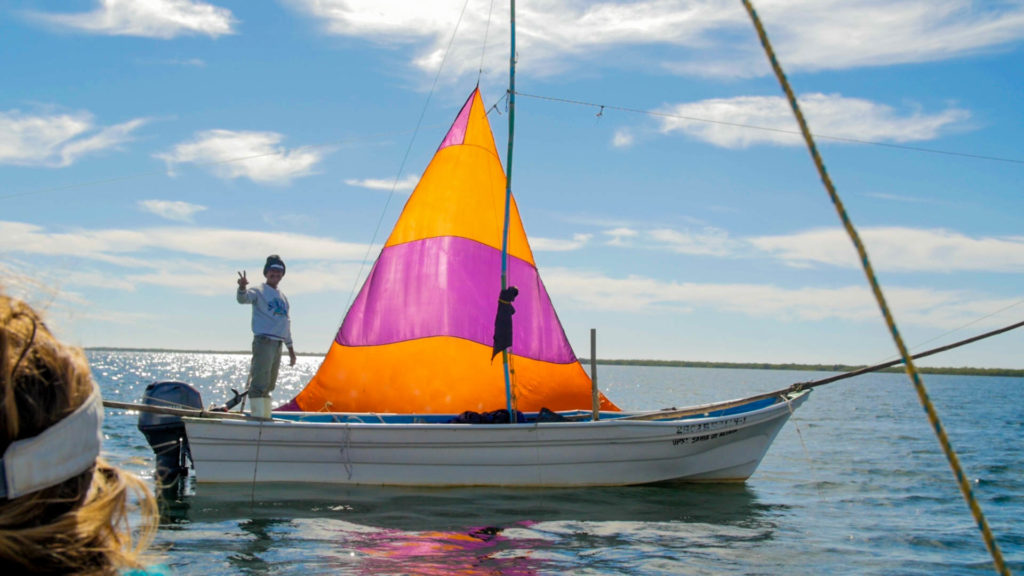
Jon and Shannon from Prism have come with Josh and me this morning, and we have plenty of time to chat together as we float down the bay. Alfonso watches his sail and nets without using his eyes, instead sensing his wind and catch with the tensioning and loosening of the sail as the wind shifts. His massive hands tie and retie a half hitch as he talks.
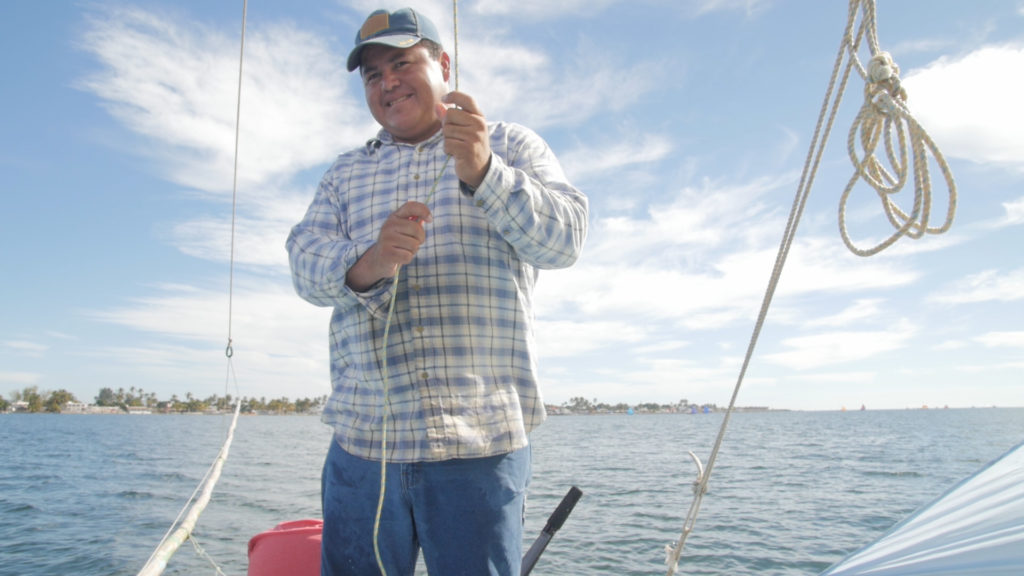
Alfonso and I are the only Spanish speakers on the boat, so I do my best to translate back and forth. Jon asks me,
“Does he think his work is sustainable?”
I have never asked this of a fisherman before—it seems too sensitive. But it’s a perfect question, really, because I want to know what he thinks about his work. We all have built up enough rapport, so I ask him Jon’s question to understand if he thinks the work is enough to support his growing family.
His reply is immediate: he firmly shakes his head no. There are more fishermen and fewer fish now, he says.
“That’s why I like the job as a server,” he says, fiddling with his net lines. So I ask him which of his jobs he prefers: fishing, or serving in the restaurant.
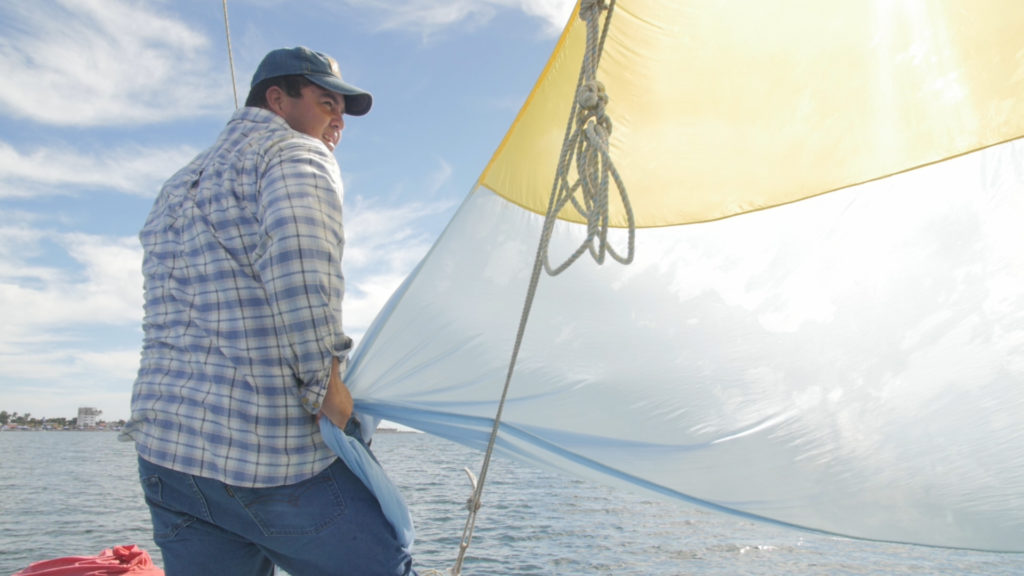
The restaurant, he replies, and I ask him why. I suspect he likes the social aspect, so his answer surprises me.
“Because of the tips,” he says. The pay is better. The money is more certain. Income is the determinant of the work—not preference for a type of work, or something that satisfies his interests. I have seen that Alfonso takes a keen interest in the shrimp, showing me how to identify male and female individuals. Although he started to pursue a degree in marine biology when he was younger, his first interest, then and now, is supporting his growing family.
Alfonso is the younger generation of a family that knows the ways of the water. But, for a better life, he wants to leave these skills behind. As fish stocks decline and the coasts change, fishermen like Alfonso must piece together a different, diversified life. For now, he can turn to tourism on the protected malecón.
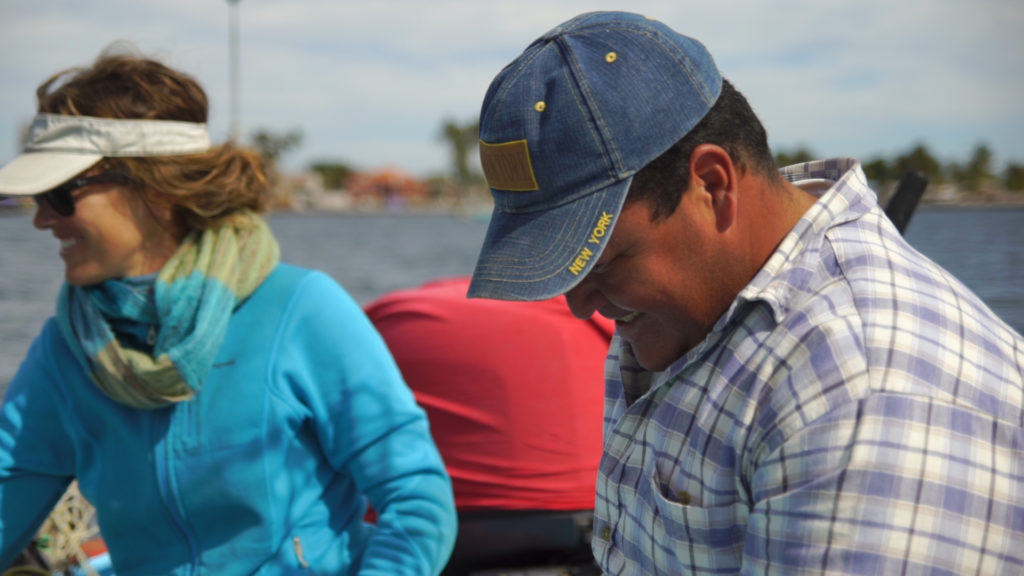
***
When he drops us off on our boat, we give Alfonso a tour inside the cabin. I study his face as he walks through the wooden interior, wondering what he’s thinking. We show him our electronic charts of Altata, the underwater lay of the land. He points out the area that used to be a different bar entrance to Altata for boats, but was reshaped and destroyed in a hurricane a few years ago and made impassable.
When he steps back into his panga, Alfonso leans on the rail to keep chatting. At one point, he looks out into the small bay.
“Look, there’s my father, my uncle, my cousin.” He turns to me and laughs.
“The only one missing is me.”
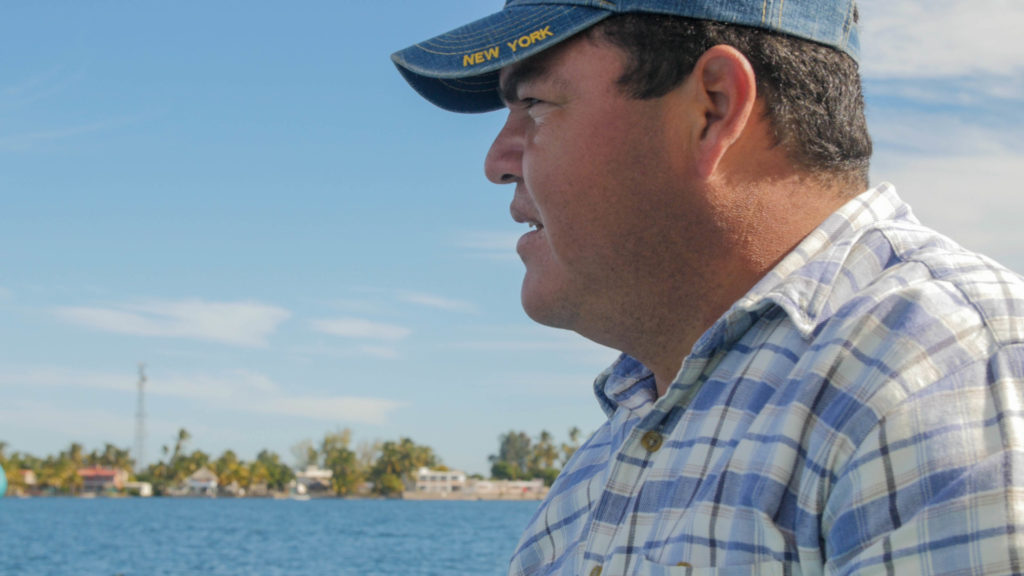
[1] However, about a month after we visited Altata, the shrimpers became the first fishery ever internationally certified “Free Trade,” a third-party certification process that standardizes sustainable practices and pay. This could allow this progressive group of shrimpers and their three cooperatives to gain a better foothold in both local and international markets.

